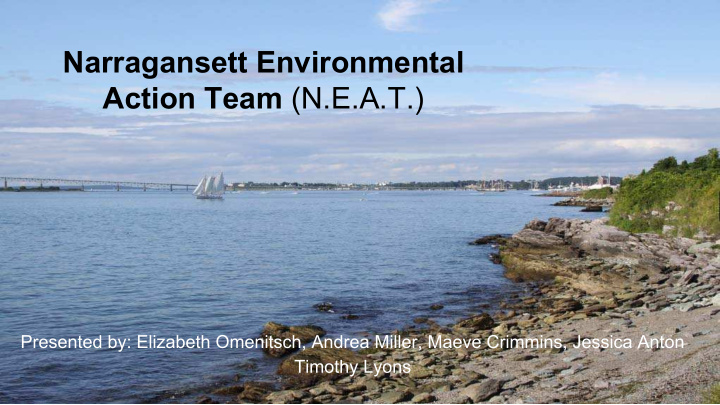



Narragansett Environmental Action Team (N.E.A.T.) Presented by: Elizabeth Omenitsch, Andrea Miller, Maeve Crimmins, Jessica Anton Timothy Lyons
Overview: ● Mission Statement ● History and Characteristics ● Population ● Land Use ● Water Use ● Environmental Problems ● Existing Organizations ● Problems and Solutions
Mission Statement: The Narragansett Bay is important economically, aesthetically, recreationally, and environmentally to Rhode Island and Massachusetts. With that in mind, it is important that the health of the Narragansett Bay watershed be maintained. The Narragansett Environmental Action Team (N. E.A.T.) plans to reduce pollutants such as phosphorus, and bacteria by 50% by the year 2025.
History ● Covers 147 square miles in Rhode Island and parts of Massachusetts ● Over 40 islands ● New England’s largest estuary ● “ria” → a drowned river valley that remains open to the sea ● Shape comes from glacier movement about 18,000 years ago ○ New sediments to expose older bedrock ○ Carved out channels that flow into the Bay ● First settlement by Europeans in 16th century Figure: Narragansett Bay Watershed & Subwatershed Basins
Characteristics ● Watershed area: 4,674 square kilometers ● 7 sub-drainage basins: ○ Warren, Woonasquatucket, Ten Mile, Taunton, Moshassuck, Pawtuxet, Hunt River and Blackstone ● Average depth = ~9.0 meters ● Water temperature range ○ 0.5 - 24 degrees Celsius ● Semidiurnal tides - 2 tides per day ○ 1.1 meters at head ○ 1.4 meters at mouth ● 11 different types of sediments recorded throughout Bay Figure: Sediments of Narragansett Bay
Population ● 2 million people ● Congregated around the bay→ heavily towards the upper part of the bay ● Most populated around the city of Providence Figure: Population Density in Rhode Island (2010)
Land Use ● Forested but in the regions closest to the Bay, the land becomes residential and commercial ● Land surrounding was mostly undeveloped ○ Small communities surrounded by rural areas ● Now densely populated ● Chemicals and fertilizers are more abundant in these parts ○ Runoff eventually leads to anoxia in the bay Figure: Land Use in Rhode Island
Water Use ● Wastewater and Stormwater Pollution and Control ○ Municipal and Regional Wastewater Facilities ○ Septic Systems ● Recreation and commercial industry ● Sailing races from Newport like the America’s Cup ○ Volvo Ocean Race ● Shellfish industry ○ Clams, oysters and mussels are indigenous to the Bay ○ Filter feeders help filter many gallons of water everyday which helps improve the watershed and the Bay
Environmental Problems: Buckeye Brook: ● Tributary creek of the Narragansett Bay ● Surrounded by residential and commercial areas ● Contamination from Fecal Coliform and Enterococci ○ Affects safe swimming and shellfishing Figure: Buckeye Brook Watershed Area Table: Pollutants within Narragansett Basin
Impervious Land ● Water applied to the ground is unable to be filtered naturally through the soil before reaching the Narragansett Bay ● Impervious land acts as a funnel to the Bay ○ Rinsing any pollutant directly into the Bay or nearby streams. Figure: Impervious Land Areas around Narragansett Bay
Existing Programs & Organizations Organizations: ● Narragansett Bay Estuary Program (NBEP) ● Save The Bay ● Narragansett Bay Commission ● Narragansett Bay National Estuarine Research Reserve (NBNERR) ● New England Interstate Water Pollution Control Commission (NEIWPCC) ● EPA’s National Estuary Program ● Rhode Island Department of Environmental Management (RIDEM) ● Massachusetts Water Pollution Control Association (MWPCA)
Problems Problem Result Cause P.1 Eutrophication Dense algal blooms excessive nutrients (nitrogen and phosphorous) from stormwater runoff, waste water treatment plants, cesspools and septic plants, industry, and impervious land P.2 Rising Water Temp/ Sea Level Rise Coastline retreats and beach erosion climate change is causing ocean temperatures to rise P.3 Hypoxia Low dissolved oxygen occurring especially excess nitrogen entering the upper Bay during the summer months P.4 Pollutants Pharmaceuticals, mercury, lead, zinc, stormwater runoff, waste water treatment copper, and other heavy metals in the water plants, cesspools and septic plants, industry, and impervious land P.5 Invasive Species Disturbance of native flora and fauna, native arrive via ballast water from shipping species outcompeted for space and sources containers, sometimes introduced as a result of food of expanding ranges due to changes in water temperature and salinity
Solutions Problem Goal P.1 Eutrophication G.1 Reduce the amount of excess S.1 Narragansett Bay Commission to help reduce the nutrients entering the Bay to reduce pollution from industry by updating water treatment eutrophication plants and removing unnecessary pavement, and installing rain gardens P.2 Rising Water Temp/ Sea Level G.2 Prevent the beach from further S.2 Begin to move industry inland, reduce carbon Rise erosion emissions to help with climate change P.3 Hypoxia G.3 Reduce the amount of nitrogen S.3 Legislation to reduce the amount of nitrogen entering the Bay entering the water via major RI and MA waterways P.4 Pollutants G.4 Reduce the amount of pollutants S.4 Narragansett Bay Commission to help with the enter the Bay via stormwater industry pollution by updating water treatment plants, runoff, waste water treatment plants, and removing unnecessary pavement, and installing and industry rain gardens P.5 Invasive Species G.5 Prevent new invasive species S.5 Federal laws to control the introduction and from entering the Bay and eradicate outbreak, Rapid Assessment Surveys to collect data already existing invasive species and analyze the situation
Recommend
More recommend